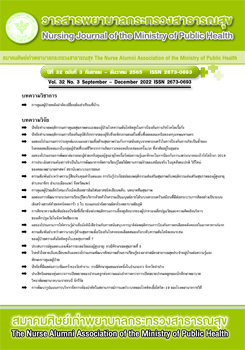ผลของโปรแกรมการประยุกต์แบบแผนความเชื่อด้านสุขภาพร่วมกับ การสนับสนุนจากครอบครัวในการป้องกันการเกิดเป็นซ้ำของโรคหลอดเลือดสมอง ในกลุ่มผู้ป่วยที่รอดชีวิตจากการเกิดภาวะหลอดเลือดสมองครั้งแรก ที่อาศัยอยู่ในชุมชน
Main Article Content
บทคัดย่อ
การวิจัยกึ่งทดลอง แบบ2 กลุ่มวัดผลสามครั้ง เพื่อศึกษาผลของโปรแกรมการประยุกต์แบบแผนความเชื่อด้านสุขภาพร่วมกับการสนับสนุนจากครอบครัวในการป้องกันการเกิดเป็นซ้ำของโรคหลอดเลือดสมอง ในผู้ป่วยที่รอดชีวิตจากการเกิดภาวะหลอดเลือดสมองครั้งแรก กลุ่มตัวอย่าง คือ ผู้ป่วยภาวะหลอดเลือดสมองครั้งแรก จำนวน 60 คน แบ่งเป็น กลุ่มทดลอง และกลุ่มเปรียบเทียบ กลุ่มละ 30 คน ระยะเวลาการศึกษา 8 สัปดาห์ เก็บรวบรวมข้อมูลด้วยแบบสอบถาม ในระยะก่อนการทดลอง หลังการทดลอง และระยะติดตามผล วิเคราะห์ข้อมูลด้วยการใช้สถิติเชิงพรรณนา Chi-square, Repeated measure ANOVA และ Independent t-test ผลการวิจัย พบว่า กลุ่มทดลองมีคะแนนเฉลี่ยพฤติกรรมป้องกันการกลับเป็นซ้ำของผู้ป่วยโรคหลอดเลือดสมองด้านการรับประทานอาหาร การรับประทานยา การมาตรวจตามแพทย์นัด การออกกำลังกาย และการสังเกตอาการเตือนของการกลับเป็นซ้ำของโรคหลอดเลือดสมอง ดีกว่าก่อนการทดลองและดีกว่ากลุ่มเปรียบเทียบอย่างมีนัยสำคัญทางสถิติ (p <.05) ผลการวิจัยครั้งนี้ สรุปได้ว่าโปรแกรมการประยุกต์แบบแผนความเชื่อด้านสุขภาพร่วมกับการสนับสนุนจากครอบครัวในการป้องกันการเกิดเป็นซ้ำของโรคหลอดเลือดสมอง สามารถทำให้ผู้ป่วยโรคหลอดเลือดสมองมีพฤติกรรมเพื่อป้องกันการกลับเป็นซ้ำของโรคหลอดเลือดสมองดีขึ้นและสามารถนำไปประยุกต์ใช้ในการดูแลผู้ป่วยในคลินิกโรคเรื้อรังอื่นๆ ได้
Article Details

อนุญาตภายใต้เงื่อนไข Creative Commons Attribution-NonCommercial-NoDerivatives 4.0 International License.
บทความและรายงานวิจัยในวารสารพยาบาลกระทรวงสาธารณสุข เป็นความคิดเห็นของ ผู้เขียน มิใช่ของคณะผู้จัดทำ และมิใช่ความรับผิดชอบของสมาคมศิษย์เก่าพยาบาลกระทรวงสาธารณสุข ซึ่งสามารถนำไปอ้างอิงได้
เอกสารอ้างอิง
World Stroke Organization. World stroke campaign [Internet].2017 [cited 2020 December 16]. Available from: https://www.world-stroke.org/world-stroke-day-campaign
National Stroke Association. Recovery after stroke [Internet].2017 [cited 2020 December 20]. Available from: http://www.stroke.org/
Bureau of Policy and Strategy, Ministry of Public Health [Internet]. Public health statistic.2017 [cited 2020 December 11]. Available from: http://dmsic.moph.go.th/index/detail/7892.(in Thai)
Sereewichayasawad N, Maneewong P, Srisuk O, Phongern N, Neilpaijit N. Factors related to hospital readmission among stroke patient in home health care unit. Journal of Public Health Nursing 2016;28(3):30-40.(In Thai)
Tepsuwan J. Recurrent prevention for stroke survivors. Proceedings of the 1th NPRU National Academic Conference. Nakhon Pathom: Silpakorn University;2018.(In Thai)
World Health Organization. The WHO STEP wise approach to stroke surveillance [Internet].2017 [cited 2020 December 16]. Available from: http://www.who.int/ncd_suveillance/en/step stroke_mannual_vl.2.pdf
Mendis S. Stroke disability and rehabilitation of stroke: World Health Organization perspective. International Journal of Stroke 2013;8(1):3-4.
Tiamkao S. Recurrent ischemic stroke in Srinagarind hospital. North-Eastern Thai Journal of Neuroscience 2011; 6(3):31-8.(In Thai)
Khumsa-ard S, Thiangtham W, Boonyamalik P. Behavior factors related to recurrent stroke. Journal of Public Health Nursing 2017;31(2):13-25.(in Thai)
Kernan WN, Ovbiagele B, Black HR, Bravata DM, Chimowitz MI, Ezekowitz MD, et al. Guidelines for the prevention of stroke in patients with stroke and transient ischemic attack: a guideline for healthcare professionals from the American Heart Association/American Stroke Association. Stroke 2014;45(7):2160-236.
Skinner CS, Tiro J, Champion VL. The health belief model. health behavior: theory, research, and practice, 5th ed. Hoboken, NJ, US: Jossey-Bass/Wiley;2015:75-94.
Powwattana A, Kalampakorn S,Lagampan S, Rawiworrakul T. Health promotion and disease prevention in community: An application of concepts and theories to practice. Bangkok: m n compute offset;2018.(in Thai)
Witee T, Thiangtham W, Boonyamalik P. The recurrent stroke prevention behavior program in post stroke patients. Kuakarun Journal of Nursing 2021;28:7-19.(in Thai)
Khiawkhwao P, Thiangtham W, Boonyamalik P. The effects of the cerebral vascular disease prevention program in high risk group patients. Journal of Health and Nursing Research 2019;35(3):120-32.(in Thai)
Thiangtham W, Kalampakorn S, Powwattana A.Community capacity building : concept and applications.4th ed. Bangkok: Danex Intercorporation;2015.(in Thai)
Strecher VJ, Rosenstock IM. The health belief model end health behavior and health education—theory, research and practice.4th ed. the United States of America: Jossey-Bass;1996.
House J. Work stress and social support. reading, MA: Addison-Wesley;1981.
Srisatidnarakul B. Effect size power analysis optimal sample size calculations using G*Power Software. Bangkok: Chula press;2020.(in Thai)
Prasat Neurological Institute, Ministry of Public Health. Stroke clinical practice guideline for nursing. Bangkok: Thana Place;2015.(in Thai)

